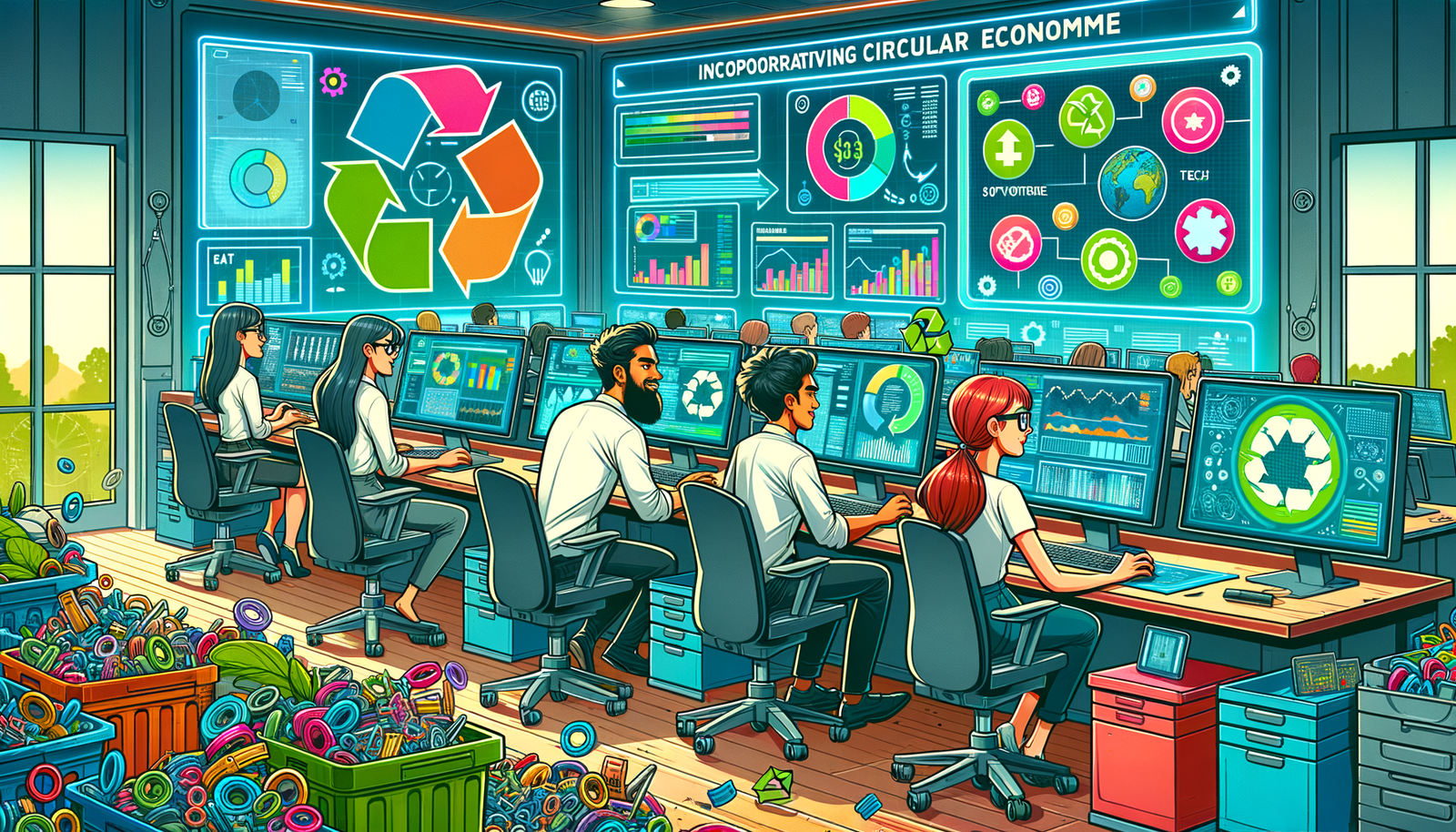Your Cart is Empty
Customer Testimonials
-
"Great customer service. The folks at Novedge were super helpful in navigating a somewhat complicated order including software upgrades and serial numbers in various stages of inactivity. They were friendly and helpful throughout the process.."
Ruben Ruckmark
"Quick & very helpful. We have been using Novedge for years and are very happy with their quick service when we need to make a purchase and excellent support resolving any issues."
Will Woodson
"Scott is the best. He reminds me about subscriptions dates, guides me in the correct direction for updates. He always responds promptly to me. He is literally the reason I continue to work with Novedge and will do so in the future."
Edward Mchugh
"Calvin Lok is “the man”. After my purchase of Sketchup 2021, he called me and provided step-by-step instructions to ease me through difficulties I was having with the setup of my new software."
Mike Borzage
Leveraging Advanced Design Software for Circular Economy Integration
October 22, 2024 6 min read


Introduction to Circular Economy Principles
The concept of the circular economy has gained significant traction in recent years as a sustainable alternative to the traditional linear economic model. In a linear economy, resources are extracted from the environment, transformed into products, and ultimately disposed of as waste after use. This "take-make-dispose" approach has led to unsustainable levels of resource depletion, environmental degradation, and an ever-increasing accumulation of waste. In contrast, the circular economy proposes a systemic shift towards a more regenerative model, where the value of products, materials, and resources is maintained in the economy for as long as possible. By promoting practices such as reducing waste, reusing resources, and recycling materials, the circular economy aims to decouple economic growth from the consumption of finite resources.
In modern design practices, the adoption of circular economy principles is becoming increasingly important. Designers have a profound influence on the sustainability of products, as decisions made during the design phase determine up to 80% of a product's environmental impact. By integrating circular economy principles into design, products can be created with longevity, reparability, modularity, and recyclability in mind. This not only reduces environmental impact but can also lead to cost savings, innovation, and competitive advantage. The role of design software in facilitating these practices cannot be overstated. Advanced design tools enable designers to model and analyze products in virtual environments, assess environmental impacts, and optimize designs for circularity. By providing the necessary tools and data, design software empowers designers to make informed decisions that align with circular economy objectives.
Essential Software Features for Circular Product Design
Material Management
At the core of circular product design is the effective management of materials. Design software that includes comprehensive material management capabilities allows designers to select and utilize materials in ways that minimize environmental impact and enhance product sustainability. Tools for tracking material sources provide transparency into the supply chain, ensuring materials are sourced responsibly and ethically. This is particularly important for avoiding materials associated with negative environmental or social impacts, such as deforestation or conflict minerals.
Understanding the lifecycle impacts of materials is crucial for assessing the overall sustainability of a product. Design software that integrates lifecycle data enables designers to evaluate factors such as energy consumption, carbon footprint, water usage, and toxicity associated with different materials. This information can guide material selection towards options that have lower environmental impacts. Moreover, by integrating databases of sustainable materials, design software provides access to a wealth of information on eco-friendly alternatives, including recycled, bio-based, or rapidly renewable materials.
An advanced material management system within design software may offer functionalities such as:
- Material Selection Wizards: Tools that recommend materials based on sustainability criteria, performance requirements, and cost considerations.
- Supplier Databases: Access to information about suppliers who provide sustainable materials, including certifications and compliance records.
- Environmental Impact Indicators: Visualization of environmental impacts related to material choices, aiding in comparing and selecting the most sustainable options.
By leveraging these material management features, designers can make proactive choices that reduce resource consumption, minimize waste generation, and enhance the recyclability of products at the end of their life. This not only supports environmental objectives but can also lead to cost savings and improved product performance.
Design for Disassembly
Design for Disassembly (DfD) is a design approach that focuses on creating products that can be easily and efficiently taken apart at the end of their useful life. This facilitates the recovery of components and materials for reuse, refurbishment, or recycling, thus extending the lifecycle of the resources used. Incorporating DfD principles into product design is essential for achieving the goals of the circular economy.
Design software plays a pivotal role in implementing DfD by providing tools and functionalities that support the creation of modular and easily disassemblable products. Software capabilities may include:
- Assembly Modeling: Tools that allow for the virtual assembly and disassembly of products, helping designers to assess the ease and efficiency of these processes.
- Connection Analysis: Features that evaluate the types of fasteners and connections used, promoting the use of reversible and non-destructive joining methods.
- Simulation of Disassembly Processes: The ability to simulate and visualize disassembly sequences, identifying potential challenges and optimizing for ease of disassembly.
By utilizing these software capabilities, designers can create products with modular components that are easily separable, reducing the time and cost associated with disassembly. This can lead to products that are more repairable, upgradable, and recyclable, thus supporting a longer product lifecycle and the conservation of resources.
In addition, designing for disassembly can have significant business benefits. Companies can develop new business models based on product-as-a-service, remanufacturing, or leasing, where the ease of disassembly enhances the feasibility and profitability of these models. By embracing DfD through advanced design software, organizations can not only meet sustainability goals but also drive innovation and create competitive advantages in the marketplace.
Lifecycle Assessment Tools
Understanding the environmental impacts of a product throughout its entire lifecycle is essential for sustainable design. Lifecycle Assessment (LCA) tools integrated into design software provide a comprehensive method for evaluating these impacts, covering stages from raw material extraction, manufacturing, distribution, use, to end-of-life disposal or recycling. Incorporating LCA into the design process allows for the identification and mitigation of environmental hotspots.
LCA functionalities in design software enable designers to perform:
- Real-Time Impact Analysis: Assessing the environmental impacts of design choices as they are made, providing immediate feedback and enabling iterative improvements.
- Scenario Modeling: Comparing different design scenarios, materials, or processes to determine which options have the lowest environmental impact.
- Compliance Check: Ensuring that designs meet environmental regulations and standards, such as ISO 14040 for LCA.
The importance of LCA in making informed design decisions cannot be overstated. By quantifying impacts such as greenhouse gas emissions, energy use, water consumption, and waste generation, designers can prioritize efforts to reduce the most significant environmental burdens. LCA also supports transparent communication of environmental performance to stakeholders, including customers, regulators, and supply chain partners.
Moreover, integrating LCA into the early stages of design can lead to innovations in product development. Designers may discover opportunities for improving efficiency, substituting materials, or reengineering processes that not only reduce environmental impact but also enhance product performance and reduce costs. Ultimately, LCA tools in design software are instrumental in achieving the dual goals of sustainability and competitiveness in the marketplace.
Future Trends and Software Innovations
The intersection of technology and sustainability is driving exciting innovations in design software, with emerging tools and platforms that enhance support for circular economy principles. One of the most significant trends is the incorporation of Artificial Intelligence (AI) and Machine Learning (ML) into design processes. AI-powered design software can analyze vast datasets to identify patterns and insights that would be difficult or impossible for humans to discern. For example, AI algorithms can optimize product geometries for material efficiency, reducing waste without compromising functionality.
Machine learning can enable predictive modeling of product performance and lifecycle impacts, allowing designers to anticipate how products will behave in real-world conditions and adjust designs accordingly. By continuously learning from new data, ML algorithms can improve over time, leading to increasingly sustainable and efficient design outcomes.
Another significant trend is the integration of design software with the Internet of Things (IoT) and sustainable sourcing platforms. IoT devices embedded in products can collect data on usage patterns, performance, and wear, providing valuable feedback to designers. This data can inform design improvements that enhance durability, efficiency, and user satisfaction. Additionally, integrating with sustainable sourcing platforms gives designers access to real-time information on material availability, costs, and sustainability credentials, enabling more informed and agile decision-making.
Predicted advancements in design software aimed at enhancing circular economy practices include:
- Cloud-Based Collaborative Platforms: Facilitating collaboration among multidisciplinary teams, suppliers, and stakeholders, promoting transparency and shared responsibility for sustainability outcomes.
- Enhanced Simulation and Virtual Reality (VR): Allowing for more immersive and accurate simulations of product performance, disassembly processes, and environmental impacts.
- Blockchain Integration: Providing secure and transparent tracking of materials and products throughout the supply chain, enhancing traceability and accountability.
These innovations reflect a broader shift towards leveraging technology to solve complex sustainability challenges. By adopting these advanced design tools, organizations can not only improve their environmental performance but also drive innovation, open new market opportunities, and build resilience in an increasingly sustainability-focused global economy.
Conclusion
The transition to a circular economy represents a significant opportunity and challenge for designers and organizations. Design software stands at the forefront of this shift, providing the tools and capabilities necessary to create products that are sustainable, efficient, and aligned with circular principles. By integrating functionalities such as material management, design for disassembly, and lifecycle assessment, design software empowers designers to make informed decisions that reduce environmental impacts and enhance product value.
Moreover, the ongoing innovations in design software, driven by technologies such as AI, ML, and IoT, are expanding the possibilities for sustainable design. These tools enable more intelligent, data-driven approaches to product development, facilitating the creation of products that meet both performance and sustainability objectives.
Designers and firms are encouraged to leverage these advanced software solutions to embrace the circular economy fully. By doing so, they can contribute to creating a more sustainable and prosperous future, where economic growth is decoupled from resource consumption and environmental degradation. It is a call to action for the design community to foster innovation, collaboration, and a shared commitment to sustainability. Embracing circular economy principles through the use of cutting-edge design software is not only an environmental imperative but also a strategic move towards long-term success in a rapidly changing world.
Also in Design News

Revit Tip: Bulk Editing in Revit: Multi‑Select with the Properties Palette
December 15, 2025 2 min read
Read More
ZBrush Tip: Convert Polygroups to Polypaint for rapid non‑destructive color blocking
December 15, 2025 2 min read
Read MoreSubscribe
Sign up to get the latest on sales, new releases and more …



